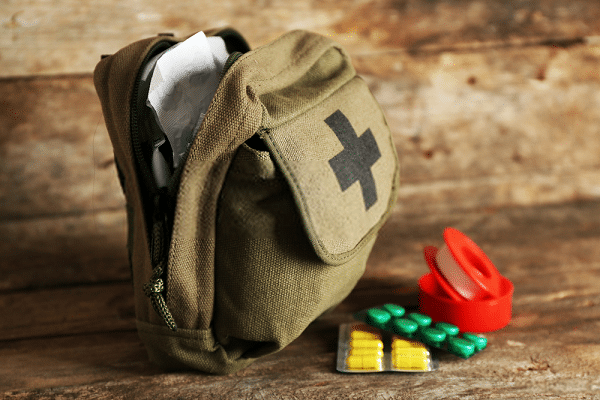The journey of childbirth is arduous and fulfilling at the same time. Mothers can face challenges adjusting to their postpartum lives. Along with the stress of taking care of their newborn, their body is changing due to hormonal fluctuations and recovery from perinatal injuries and wounds. Predominant among the injuries are incision wounds which might result from an episiotomy or a C-section. An episiotomy is a procedure where a skin or perineal tissue incision is given to widen the vaginal canal to aid in the delivery of the child. Caesarean section on the other hand is a procedure where the newborn is taken out of the womb by a transverse or vertical lower umbilical incision. These incision wounds have some postpartum complications that need attention.
Predating back to the ancient times of the Egyptians, use of sea saltwater was a well established modality for treating wounds. Salt had been known to show antiseptic and antibacterial benefits. Salt water primarily acts by the process of osmosis and dehydration of the damaged tissue. The sodium chloride component makes the water from the cell come out, which also includes the bacterial components, effectively dehydrating with antibacterial traits. However, recent studies state that sea saltwater also contains all sorts of microorganisms and material coming downstream from the rivers. Therefore salt-baths of today are more towards the saline solution containing sodium chloride and water.
Care of an episiotomy wound
It is fair to note that some females also get vaginal tears despite not having an episiotomy due to the pressure exerted by the head and body of the fetus. It can be a discomforting and painful recovery, therefore home care and management is important to ease the process. The following recommendations can be used however they are not exhaustive. Always consult with your healthcare practitioners. Many physiotherapists suggest using an ice pack immediately following a delivery for approximately 10 minutes. The icing serves to relieve the pain and further numb the area, leading to a reduction in swelling and inflammation. As an alternative to simple ice packs, perineal ice pads can be employed. Along with the icing, it has an additional pad which can further add to the comfort. A twisting motion to the pad brings about the coldness needed to reduce the swelling.
During the first couple of weeks in the postpartum period, the wound should be kept clean and dry to promote fast healing. Gently washing after urination and defecation with tap water or cotton balls soaked in an antiseptic solution helps a lot. One should make sure to regularly change their sanitary pads. The wound area can be kept dry by either using a hairdryer on low settings or if possible, exposing the wound to air. It is also of importance to avoid sitting in one position for a long time. Some intervals of mobility and use of a support material to sit on can help in reducing the soreness. Painkillers such as acetaminophen and ibuprofen can be used to alleviate pain. Ibuprofen in particular has a potent response for episiotomy wounds and postpartum uterine pain. Both these drugs belong to the non-steroidal anti-inflammatory drugs group, and are marked safe for the use of a breastfeeding mother. These can be taken in the form of oral pills, sprays and gels.
During the course of the initial postpartum period, the mother should stay hydrated as it stimulates the bowel movements and avoids constipation. Further stool softeners are used to decrease the bulk and hardness of excreta in order to avoid pressure on the wound site. Sitz bath is another common therapy that can be undertaken at the homeplace. Sitting in a small basin of warm water with some salt in it helps with healing due to antiseptic and antibacterial properties of the solution. Further ice can be added as a cold Sitz bath has shown a higher efficacy for faster healing and relief from pain. Pelvic floor exercises also promote healing and improve circulation to the pelvic floor. Postpartum mothers should avoid sexual activity till complete wound healing. It is also important to refrain from using talcum powder, hot water, hot pads, tampons and vaginal cleansers during the time of recovery. Excessive squatting also needs to be avoided.
Care of a Caesarean Wound
Following a C-section, special care needs to be taken to address the abdominal wound. C-section is a major surgical operation and its healing is also slow as compared to an episiotomy wound. The healing further depends on the obstetric and medical history of the patient, therefore it varies from one individual to another. Pain killers, as mentioned earlier for episiotomy wounds, need to be taken regularly for up to two weeks of the delivery, to prevent pain from the incision wound. Early mobility is also crucial for the early healing of the wound and for prevention of developing any clots. Mostly dissolvable sutures are used in a C-section incision, but in few cases, non-dissolvable or metallic stitches need to be removed within a week. Breastfeeding can be started at any time following the delivery.
Proper management of the wound at home is the most important step in the entire healing process. The wound is often covered with a waterproof dressing before discharge from the hospital. Still, important emphasis needs to be placed on keeping the dressing dry and clean. Timely replacement of dressings with use of proper antiseptics speeds up the healing while also preventing formations of a pus or an underlying infection. While the mother can bathe, the dressing should not be allowed to get wet. Wound pain decreases in intensity as the postpartum period progresses.
Being close to your baby is very important mind you they need extra doses of love and nurturing being in the outside world is new to them. Discomforts of postpartum period can make the entire experience challenging and stressful therefore taking proper care of the wounds can decrease the discomfort and add joy to the experience.

